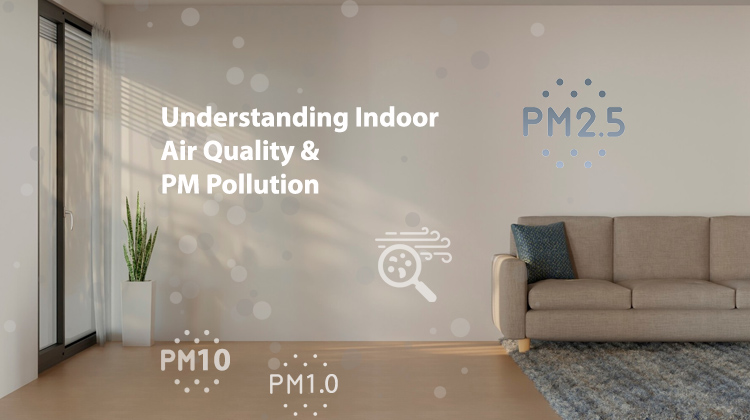What is Particulate Matter (PM) and How It Affects Indoor Air Quality?
Indoor air quality plays a crucial role in our health and well-being, yet it is often overlooked. Many pollutants contribute to poor indoor air, but one of the most significant and harmful is particulate matter (PM). These tiny airborne particles can come from a variety of sources and pose serious health risks, especially when inhaled over long periods. Understanding what PM is, how it affects indoor air quality, and how to monitor it effectively is essential for maintaining a healthy indoor environment.
Understanding Particulate Matter (PM)
Particulate matter refers to a mixture of solid particles and liquid droplets suspended in the air. These particles vary in size, composition, and origin, but they are mainly categorized based on their diameter: PM1.0, PM2.5, and PM10. PM10 includes larger particles like dust, pollen, and mold spores, which are typically filtered out by our respiratory system. However, PM2.5 and PM1.0 are much smaller and can penetrate deep into the lungs, potentially entering the bloodstream. These finer particles often originate from combustion processes such as vehicle emissions, industrial pollution, cooking, and smoking.
Unlike gases like carbon dioxide (CO2) and volatile organic compounds (VOCs), PM consists of physical particles that can remain suspended in the air for extended periods. This makes them a major concern for indoor air pollution, particularly in enclosed spaces where ventilation is limited.
How Does Particulate Matter Impact Indoor Air Quality?
Indoor air pollution is often more concentrated than outdoor air due to the accumulation of pollutants in confined spaces. PM can enter indoor environments through open windows, doors, and ventilation systems, especially in urban areas where outdoor pollution is high. However, indoor sources of PM also contribute significantly. Activities such as cooking, burning candles or incense, using fireplaces, smoking, and even dusting can release particulate matter into the air.
Once PM particles are airborne, they remain suspended for long periods, especially in poorly ventilated areas. Over time, they settle on surfaces but can easily become airborne again through movement or air circulation. Without proper air filtration, PM levels can rise, leading to poor indoor air quality that affects respiratory health and overall well-being.
Health Risks Associated with Particulate Matter Exposure
Exposure to high levels of PM can have both immediate and long-term health effects. In the short term, individuals may experience eye irritation, coughing, sneezing, throat discomfort, and difficulty breathing. Those with preexisting conditions such as asthma or allergies are particularly vulnerable to worsening symptoms.
Long-term exposure to fine particulate matter, especially PM2.5 and PM1.0, is associated with serious health conditions, including chronic respiratory diseases, cardiovascular disorders, weakened immune function, and even neurological effects. These fine particles are small enough to bypass the body’s natural defenses, reaching the lungs and bloodstream, where they can contribute to lung diseases, heart disease, and an increased risk of stroke. Studies have also linked prolonged exposure to PM with cognitive decline, stress, and reduced sleep quality.
How to Monitor and Improve Indoor Air Quality?
Maintaining good indoor air quality requires an understanding of pollutant sources and proactive steps to reduce PM exposure. The most effective way to manage air quality is through real-time air quality monitoring, allowing individuals to track pollution levels and take necessary actions.
A high-quality air quality monitor like HibouAir provides continuous data on PM levels, CO2, VOCs, temperature, and humidity. By using precise sensors, HibouAir helps users identify sources of pollution and make informed decisions to improve air quality. For those particularly concerned about PM exposure, the HibouAir PM Sensor is designed specifically to track particulate matter in real time.
Proper ventilation is another key factor in reducing PM levels indoors. Regularly opening windows, using air purifiers with HEPA filters, and ensuring proper maintenance of HVAC systems can help filter out fine particles and prevent accumulation. Additionally, minimizing indoor sources of pollution—such as reducing the use of candles, avoiding smoking indoors, and using eco-friendly cleaning products—can make a significant difference in maintaining a cleaner and healthier indoor environment.
Why Choose HibouAir for Air Quality Monitoring?
When it comes to indoor air quality solutions, HibouAir stands out as an advanced yet easy-to-use device designed for homes, offices, schools, and industrial spaces. Unlike traditional air quality monitors that require complex setups, HibouAir offers a plug-and-play experience, allowing users to start monitoring their environment instantly.
One of the biggest advantages of HibouAir is its real-time data tracking and analytics, enabling users to observe air quality trends, receive alerts, and make data-driven decisions. The HibouAir Standalone Monitor is perfect for those who need a simple yet powerful air quality monitoring solution without relying on Wi-Fi or cloud services. For businesses and smart buildings, HibouAir Cloud Solutions provide historical data logging and advanced analytics to ensure compliance with air quality regulations and create a healthier workspace.
Particulate matter is an invisible yet serious threat to indoor air quality, with long-term health implications that should not be ignored. Without proper monitoring, PM levels can accumulate unnoticed, leading to poor respiratory health and increased risk of chronic diseases. Investing in an air quality monitoring system like HibouAir allows individuals and businesses to proactively manage air quality, reduce pollution sources, and create a safer indoor environment.
Take control of your indoor air today!
Related Articles from Our Blog

